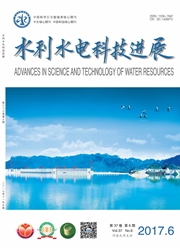

 中文摘要:
中文摘要:
为研究不同水文期不同水体混合模式下大宁河库湾的营养盐行为,基于2012年大宁河的现场监测数据,分析营养盐时空分布特征,采用箱式模型对不同水文期营养盐的收支量进行计算,以期为制定大宁河富营养化和水华控制策略提供理论依据。试验及计算结果表明:在泄水期,干流水体通过表层逆向进入库湾,而支流水体通过底层潜流向河口运输;在汛限期和蓄水期,干流水体主要通过中上层逆向进入库湾,而支流水体通过底层潜流向河口运输。干流对支流的逆向顶托作用常年存在,泄水期、汛限期、蓄水期干流对支流的贡献率分别为70.38%、28.42%和59.56%。在水体混合过程中,库湾上游来水以及干流顶托来水的混合作用是控制库湾水化学组成的主要物理因素。
 英文摘要:
英文摘要:
To investigate the behaviors of nutrients in the Daning Bay of the Three Gorges Reservoir under different modes of water body mixing in different seasons, the spatial-temporal distribution of nutrients was analyzed based on field data collected from the Darting Bay in 2012. The seasonal variations of nutrients were calculated using the box model, which was expected to provide a theoretical basis for the formulation of a strategy for controlling the eutrophication and algal bloom in the Daning Bay. Experimental and calculated results show that during the discharge period, the mainstream water flowed into the Daning Bay upwardly through the upstream surface current, while the tributary water flowed to the estuary through the bottom density current. During the flood and storage periods, the mainstream water flowed into the Daning Bay upwardly through the upstream surface and middle-layer currents, while the tributary water flowed to the estuary through the bottom density current. The function of the mainstream water body against the flow from tributary perennially exists. The contribution rates of the mainstream to the tributary during the discharge period, flood period, and storage period were 70. 38%, 28.42%, and 59. 56%, respectively. During the water mixing process, the interaction of the water from the Daning Bay upstream and the water from the mainstream was the main physical mechanisms to control the chemical composition of the Daning Bay.
 同期刊论文项目
同期刊论文项目
 同项目期刊论文
同项目期刊论文
 期刊信息
期刊信息
